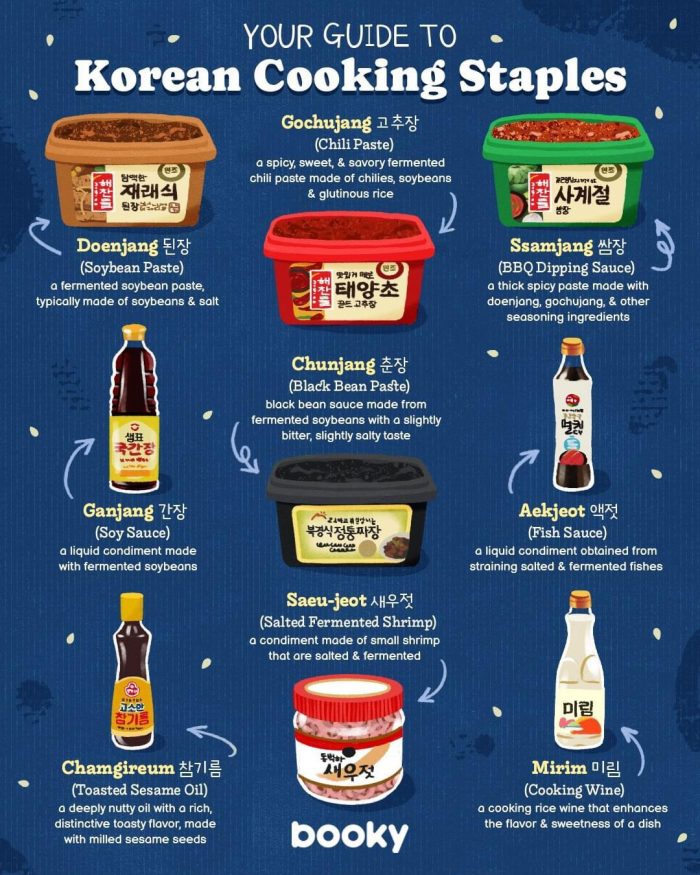
Korean cuisine is one of the healthiest and most nutritious in the world. It’s also delicious, varied, and easy to make at home. This guide will walk you through all of the essential ingredients that every beginner cook should have on hand in their pantry. These staples can be used across a wide range of dishes including soups, stews, stir-fries and fried rice dishes.
Doenjang
Doenjang is a fermented soybean paste that is used in many Korean dishes. It’s commonly used in Kimchi and other traditional dishes, but it can also be found alongside other ingredients on the table at any restaurant or home kitchen. Doenjang has a very distinct taste and smell, which some people may find off-putting at first. But once you’ve had it once or twice, you’ll soon come to appreciate this rich flavor!
Gochujang
Gochujang (red pepper paste) is a fermented paste made from red chili powder, glutinous rice powder, and salt. It’s a staple of Korean cuisine that can be used in a variety of dishes including bibimbap and kimchi. Gochujang has a spicy flavor similar to that of sriracha sauce or Tabasco sauce; however it’s much thicker than either of those options–it’s almost like condensed tomato paste! Gochujang has been around since ancient times (over 2,000 years ago!) so there are many different recipes for making it depending on where you live or what region your family comes from. The most traditional way involves mixing all the ingredients together into one large pot then letting them ferment together for several months before using them as needed throughout the year–this method requires very little oversight while still producing excellent results every time!
Ssamjang
Ssamjang, or ssamjangguk (a soup made with ssamjang), is a spicy paste made from fermented soybean paste, gochujang and other seasonings. It’s often used as a dipping sauce for Korean barbecue, but it can also be added to stews or served over rice. Ssamjang typically contains ground pork and scallions along with seasoning like garlic, ginger and onions. The mixture is blended until smooth before being seasoned with salt and pepper to taste.
Ganjang
Ganjang (soy sauce) is a salty seasoning made from soybeans, wheat and salt. It’s used to season many Korean dishes, including bibimbap, bulgogi and kimchi. There are many brands available in stores but the best ones are homemade by local people–you can find them at farmers markets or specialty stores if you ask around! It’s important to know that there are two main varieties: regular (also called “black”) ganjang and light brown (“red”) ganjang. Both contain the same ingredients but they’re prepared differently; black ganjang has more color because it’s fermented longer than red ganjang which means it has less sodium content but also less umami flavor profile due to fermentation process being stopped sooner than other types’ fermentation processes would allow them too so always make sure that whatever kind you choose has been aged properly before purchasing it from any store near your home town.
Chunjang
Chunjang, also known as fermented soybean paste, is a condiment that has been long used in Korean cuisine. It’s made from soybeans, salt and water; so it’s salty and has a strong, earthy taste. The fermentation process gives chunjang some interesting properties which make it useful as an ingredient in marinades or sauces for soups or stews.
Aekjeot
Aekjeot (black fermented seafood sauce) is a traditional Korean ingredient that’s made with shrimp, fish and salt. It’s used in many different dishes, from banchan to dumplings to soups and stews.
Chamgireum
Chamgireum is a staple of Korean cuisine, and it’s used in the same way as sesame oil in Western cooking. You can use it as a marinade or dipping sauce, or simply drizzle it over your favorite dishes–think salads, vegetables and kimchi!
Saeu-jeot
Saeu-jeot (salted shrimp) is a common Korean condiment that’s often served alongside bap (rice). It’s made from tiny dried shrimp that have been salted and fermented, giving them a robust flavor. Shrimp is rich in protein and vitamin A, so it’s a good idea to keep some on hand if you’re trying to eat healthier! In addition to being used as an ingredient or garnish for other dishes, saeu-jeot can also be eaten straight off the spoon as an appetizer or snack. If you want something more substantial than just salty shrimp with your beer at the bar, try making kimchi fried rice with saeu-jeot stirred right into the mix–it’ll give your meal tons of flavor without being too overpowering for those who aren’t big fans of seafood (or strong flavors).
I hope that you’ve enjoyed learning about these Korean cooking staples. There are so many great recipes out there, and now with your new knowledge of these ingredients, you can go forth and make them!
